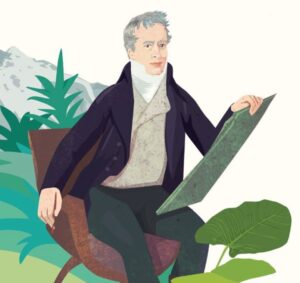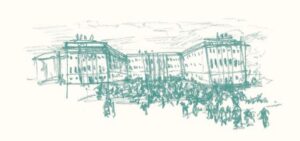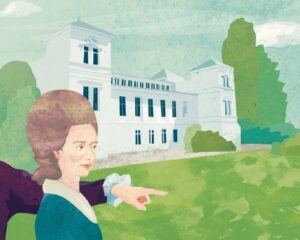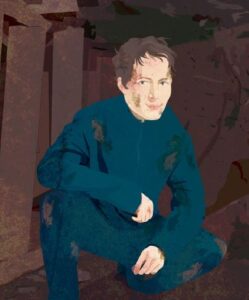On March 20, 2020, the Smithsonian American Art Museum was scheduled to debut a brand new exhibit to the public: after months of preparation, Alexander von Humboldt and the United States: Art, Nature, and Culture was finally ready to open its doors. The exhibit describes the myriad ways in which the nineteenth-century naturalist and explorer Alexander von Humboldt influenced art, exploration, nature, politics, and the very cultural basis of the United States.
However, with the arrival of COVID-19 and resulting lockdown orders, the exhibit was unable to physically open; instead, Alexander von Humboldt and the United States can be experienced virtually! As we await the opening of the exhibit, we recommend you join curator Eleanor Jones Harvey on her virtual tour of the fascinating exhibit below. And, in celebration of the new exhibit and the lasting accomplishments of Alexander von Humboldt, we’re sharing an excerpt from our book about the great explorer and scientist, The Incredible yet True Adventures of Alexander von Humboldt by Volker Mehnert and Claudia Lieb. Scroll down to take the tour, and to read a colorful introduction to this lost hero of science!
***
Prologue
 December 1827, in the Prussian capital of Berlin. Crowds have gathered in front of the university. There is so much chaos in the neighboring streets that even police on horseback cannot break up the throng. Normally there would only be a few professors and their students—but today there are hundreds, perhaps even thousands of people pushing to get in. What is going on? A man is giving a lecture and half the city is eager to hear him. Nothing like this has ever happened before. The man’s name is Alexander von Humboldt and his speech is neither boring nor bookish. On the contrary, he is a mesmerizing storyteller. He speaks freely to the crowd without using notes. Humboldt is talking about his adventures across North and South America, through tropical jungles, to the tops of volcanoes, and crossing paths with new and interesting people he’s never seen before. But he also has exciting new knowledge to share about the oceans and cosmos, geology and climate, magnetism and electricity.
December 1827, in the Prussian capital of Berlin. Crowds have gathered in front of the university. There is so much chaos in the neighboring streets that even police on horseback cannot break up the throng. Normally there would only be a few professors and their students—but today there are hundreds, perhaps even thousands of people pushing to get in. What is going on? A man is giving a lecture and half the city is eager to hear him. Nothing like this has ever happened before. The man’s name is Alexander von Humboldt and his speech is neither boring nor bookish. On the contrary, he is a mesmerizing storyteller. He speaks freely to the crowd without using notes. Humboldt is talking about his adventures across North and South America, through tropical jungles, to the tops of volcanoes, and crossing paths with new and interesting people he’s never seen before. But he also has exciting new knowledge to share about the oceans and cosmos, geology and climate, magnetism and electricity.
 Humboldt has been lecturing several times a week for half a year and word of his captivating presentations has spread throughout the city. Everyone wants to catch a glimpse of the famous explorer, to hear him speak, and everyone wants to get a good seat. The people come from every walk of life: teachers and students, craftspeople and laborers. Even the king of Prussia attends. Women, who were not allowed to attend universities in those days, are also permitted to come. The lectures are free. And the lucky attendees leave awestruck every time. It’s no wonder that the university lecture halls are soon bursting at the seams and Humboldt has to relocate to a nearby public concert hall with room for a thousand listeners. A groundbreaking transformation is underway: The study of science, previously conducted behind closed doors and discussed only by a select few, has suddenly become more accessible and understandable for anyone. And the blazing hero of this revolution is none other than Alexander von Humboldt, who will come to be known as one of the most famous scientists of the century—in spite of the fact that, as a young boy, he was somewhat less promising. . . .
Humboldt has been lecturing several times a week for half a year and word of his captivating presentations has spread throughout the city. Everyone wants to catch a glimpse of the famous explorer, to hear him speak, and everyone wants to get a good seat. The people come from every walk of life: teachers and students, craftspeople and laborers. Even the king of Prussia attends. Women, who were not allowed to attend universities in those days, are also permitted to come. The lectures are free. And the lucky attendees leave awestruck every time. It’s no wonder that the university lecture halls are soon bursting at the seams and Humboldt has to relocate to a nearby public concert hall with room for a thousand listeners. A groundbreaking transformation is underway: The study of science, previously conducted behind closed doors and discussed only by a select few, has suddenly become more accessible and understandable for anyone. And the blazing hero of this revolution is none other than Alexander von Humboldt, who will come to be known as one of the most famous scientists of the century—in spite of the fact that, as a young boy, he was somewhat less promising. . . .
Chapter 1
“Have you been poking around in the garden again with the beetles and flowers?” the strict tutor asked the young boy. Alexander was supposed to have his nose buried in books, but the young man thought that rocks, insects, and plants were so much more interesting. His grades were mediocre at best, to the point that his parents even worried he might not be very smart. They often compared him with his brother, Wilhelm, which wasn’t fair at all. His tutor made him do the exact same lessons as his studious brother, even though Wilhelm was two years older. It was simply impossible for Alexander to keep up. Yet even though he was shy and sometimes sickly, he was actually a good learner. At heart, however, he was interested in other things. While Wilhelm was happy to study languages like Latin and Greek and to read about literature and philosophy, Alexander was more curious about plants, animals, and nature in general. The quiet, slender boy went out in search of creatures in the large park that surrounded the Humboldt family’s small castle in Berlin. Alexander’s father was an officer and chamberlain at the court of the Prussian king and so could afford such a splendid residence and property, which Alexander couldn’t help but explore.
 As he got older, Alexander continued to spend as much time outside as possible. He was always on the move. “That boy loves adventuring,” his tutor complained. Alexander’s curiosity drew him again and again to the city botanical gardens, where he marveled at the palms and other gigantic trees from tropical regions while dreaming of faraway lands. Oh, how he wished he could see these plants in their native soil! At home, he pored over every book by brave travelers and groundbreaking explorers that he could get his hands on. He especially liked the adventures of the British explorer James Cook. But sadly, after the sudden death of his father, his strict mother took over his education. Alexander had to put aside his daydreams of botany and world travel and focus instead on his studies: state finance and economics. It wasn’t until Alexander was a student at the University of Göttingen that he would finally be able to pursue his passion. There, Alexander was delighted to meet a man who had sailed with Cook for three years: Georg Forster. No other German had seen as much of the world. Forster’s book of travel narratives was a hit. His tales of experiences in faroff lands and unknown islands in the South Sea fanned the flames of Alexander’s wanderlust. Alexander began by first visiting places close to home. Together with Georg, he journeyed to France, the Netherlands, and England. In London, England’s capital, he was especially intrigued by all the ships that were docked in the bay. Their cargo included sugar, tea, spices, and other wares from the farthest reaches of the earth. Alexander’s longing for travel grew bigger and bigger.
As he got older, Alexander continued to spend as much time outside as possible. He was always on the move. “That boy loves adventuring,” his tutor complained. Alexander’s curiosity drew him again and again to the city botanical gardens, where he marveled at the palms and other gigantic trees from tropical regions while dreaming of faraway lands. Oh, how he wished he could see these plants in their native soil! At home, he pored over every book by brave travelers and groundbreaking explorers that he could get his hands on. He especially liked the adventures of the British explorer James Cook. But sadly, after the sudden death of his father, his strict mother took over his education. Alexander had to put aside his daydreams of botany and world travel and focus instead on his studies: state finance and economics. It wasn’t until Alexander was a student at the University of Göttingen that he would finally be able to pursue his passion. There, Alexander was delighted to meet a man who had sailed with Cook for three years: Georg Forster. No other German had seen as much of the world. Forster’s book of travel narratives was a hit. His tales of experiences in faroff lands and unknown islands in the South Sea fanned the flames of Alexander’s wanderlust. Alexander began by first visiting places close to home. Together with Georg, he journeyed to France, the Netherlands, and England. In London, England’s capital, he was especially intrigued by all the ships that were docked in the bay. Their cargo included sugar, tea, spices, and other wares from the farthest reaches of the earth. Alexander’s longing for travel grew bigger and bigger.
 When he came back to Germany, Alexander once again had to put his dreams 9 on hold. His mother wouldn’t tolerate any further escapades. “You need to get a dependable job,” she demanded. She expected Alexander to have a career as an officer in the Prussian civil service, like his father. Not wanting to disappoint, Alexander decided to continue his education at the Mining Academy in Freiburg. At least here he would be able to study the natural sciences. He was fascinated by everything that took place in the belly of the earth. It wasn’t enough for him to learn about such things from books and teachers. Alexander had to go to the mines, where he could creep and crawl through their dark narrow shafts. He was transfixed, drawn to the subterranean rocks, metals, minerals, and gases. He examined every detail of the materials. By the time he was only twenty-¬two years old, Alexander had finished his studies and gotten a job as a mining inspector. His task was to monitor coal, salt, and gold mines and to increase their yields. He was a restless young man, so while doing his job he also wrote textbooks and even started a new school for miners. He began to discover that he was good at inventing things: Alexander developed a new type of mining lamp and a breathing mask—tools that helped miners in their dangerous work. He was quickly promoted and his future as a civil servant seemed bright. As a Prussian official, he now wore a uniform. The daydreaming young Alexander had become the esteemed Baron von Humboldt. He might even one day be a minister in the king’s court! But then, in 1796, his mother died after a long battle with cancer. Both brothers inherited a large fortune. Of course, all of his relatives were furious when Alexander promptly quit his job. “I’m off ,” he announced, “to travel the world and sail across oceans.” Doing so, however, was going to prove more challenging than he could imagine.
When he came back to Germany, Alexander once again had to put his dreams 9 on hold. His mother wouldn’t tolerate any further escapades. “You need to get a dependable job,” she demanded. She expected Alexander to have a career as an officer in the Prussian civil service, like his father. Not wanting to disappoint, Alexander decided to continue his education at the Mining Academy in Freiburg. At least here he would be able to study the natural sciences. He was fascinated by everything that took place in the belly of the earth. It wasn’t enough for him to learn about such things from books and teachers. Alexander had to go to the mines, where he could creep and crawl through their dark narrow shafts. He was transfixed, drawn to the subterranean rocks, metals, minerals, and gases. He examined every detail of the materials. By the time he was only twenty-¬two years old, Alexander had finished his studies and gotten a job as a mining inspector. His task was to monitor coal, salt, and gold mines and to increase their yields. He was a restless young man, so while doing his job he also wrote textbooks and even started a new school for miners. He began to discover that he was good at inventing things: Alexander developed a new type of mining lamp and a breathing mask—tools that helped miners in their dangerous work. He was quickly promoted and his future as a civil servant seemed bright. As a Prussian official, he now wore a uniform. The daydreaming young Alexander had become the esteemed Baron von Humboldt. He might even one day be a minister in the king’s court! But then, in 1796, his mother died after a long battle with cancer. Both brothers inherited a large fortune. Of course, all of his relatives were furious when Alexander promptly quit his job. “I’m off ,” he announced, “to travel the world and sail across oceans.” Doing so, however, was going to prove more challenging than he could imagine.
***

We hope you enjoyed the digital walkthrough of the Smithsonian American Art Museum’s dazzling exhibit, along with this brief excerpt. Be sure to pick up a copy of The Incredible yet True Adventures of Alexander von Humboldt! And don’t forget to share your favorite facts about this renowned explorer, inventor, scientist, and naturalist on Twitter with us, @experimentbooks. Happy reading!


